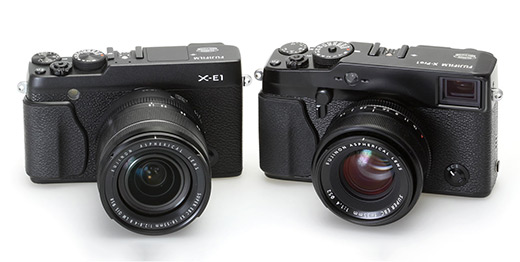
Announced today, the latest addition to Fujifilm’s semi-pro X series is a smaller version of the X-Pro 1. The X-E1 retains the same APS-C sensor as the older model but loses the hybrid viewfinder. Instead, it gains a much-improved 2.36 million-dot OLED EVF.
The new Fuji will go head to head with Sony’s NEX-7 and the very well-received Olympus OM-D. However, while both the Sony and Fuji have large APS-C sensors (1.5x crop factor), the Olympus is an M43 camera with the smaller sensor (2x crop). The XE-1 will also be a potential competitor for Leica’s new APS-C M-mount ME camera which is expected to be launched on September 17.
Along with the new camera come a couple of very interesting lenses, including an 18-55 f/2.8-4 zoom, the first non-prime for the X-mount, offering a 35mm equivalent of 27-82mm. Fuji claim the new lens, which will be sold as a kit with the X-E1, has lightening-fast autofocus, thanks to the new linear motor, and optical image stabilisation.
Adding to the X-mount lens lineup is a wide-angle 14mm (21mm equivalent) f/2.8 which Fuji claims overcomes many of the distortion problems common with wide-angle lenses.
Improved manual focus
One claim that hasn’t gone unnoticed here is that manual focus has been vastly improved. This was one of the bugbears with the original X-Pro 1, although new firmware, common to both models, will improve the original camera in that respect.
I have been looking for a body to pair with my family of manual-focus Leica lenses (Fuji offer a Leica mount as an accessory) and the Sony NEX-7 is on my list. But I am looking forward to trying the manual focus when I can get my hands on an X-E1. I certainly prefer the retro-styling and conventional manual controls of the Fuji range.
Another factor that Fuji enthusiasts will have noticed is that the new camera overlaps with the existing fixed-lens X100 which had a great deal of popularity when it was introduced last year, competing directly with Leica’s X1. It can now be argued that the new X-E1 fitted with Fuji’s 18mm (27mm) pancake is a better choice than the X100. It isn’t much bigger but offers the versatility of interchangeable lenses.
Comparisons
The two main competitors for the X-E1 are Sony’s NEX-7 and the Olympus OM-D. It is interesting to compare the specifications: First, weight, including batteries and SD card: The OMD is heaviest at 425g, the XE-1 lightest (surprisingly) at 350g, while the Sony is a tad heavier at 353g.
The OM-D is again bigger overall with dimensions of 122x89x43mm. It also has that big bump of a viewfinder module stuck on top. The Sony is the smallest, but only just. It measures 120x64x43mm compared with the Fuji’s 129x75x38mm.
To all intents and purposes, then, the X-E1 is very much comparable in size and weight with the Sony NEX-7. The OM-D, despite its good reception by critics, is both heavier and bulkier and suffers from having a smaller sensor.
by Mike Evans, 6 September 2012
